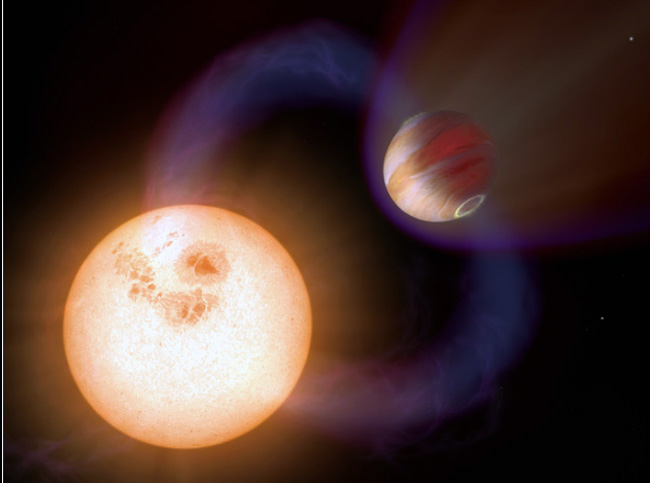
This story was updated at 1:45 p.m.EDT.
A recently spied planet orbits so close to its star that a new year comes every10 hours.
CalledSWEEPS-10, the planet [image]belongs to a newfound class of zippy exoplanets called ultra-short-period planets (USPPs) that have orbits of less than a day.
The Hubble Space Telescoperecently spotted five USPPs, all about the size ofJupiter, in a crowded star field [image]near the galacticbulge of our Milky Way galaxyas part of an exoplanet survey called the SagittariusWindow Eclipsing Extrasolar Planet Search (SWEEPS). Atotal of 16 planet candidates were found, all with relatively short orbitalperiods.
"Theseare the farthest planets detected so far around some of the faintest stars,"study leader Kailash Sahuof the Space Telescope Science Institute (STScI) inMaryland told reporters at a NASA press conference.
Extrapolatedto the entire Galaxy, the Hubble results suggest the Milky Way contains atleast 6 billion Jupiter-sized planets, researchers say.
Get the Space.com Newsletter
Breaking space news, the latest updates on rocket launches, skywatching events and more!
The findingsare detailed in the Oct. 5 issue of the journal Nature.
The newplanets were discovered using the transit technique, in which researcherscalculate a planet's mass and size based on the periodic dimming of starlightthe planet creates when it passes in front of its parent star.
Previously,the shortest known orbital period for a planet was 1.2 days and belonged to a"hotJupiter," a giant gas planet that also orbited close to its star. Inour solar system, Mercury is theclosest planet to our Sun and has anorbital period of 88 days. Earth,located farther away, takes about 365 days to make one full orbit.
Unlike withhot Jupiters, the stars the USPPsorbit are small. The star that SWEEPS-10 orbits has less than half the mass ofour Sun. The stars' small sizes arelikely what allow the planets to orbit so close, the researchers say. Planets orbiting larger stars at suchclose ranges would be destroyed.
"Ifsun-like stars have this kind of planet close to the star, it would simplyevaporate the planet," Sahu said.
SWEEPS alsoconfirmed something that astronomers have long suspected: that stars rich inheavy elements like carbon and iron are more likely to have planets.
"Wewanted to now if this holds halfway around the galaxy," said study teammember Mario Livio, also of STScI."We found that indeed, it does hold. If you find a star rich in heavyelements, there's a high probability that there will be a planet around it."
Alan Boss,a planet expert at the Carnegie Institution of Washington who was not involvedin the study, said the new findings underscore the fact that the three types ofplanets found in our solar system--rocky planets, ice giants and gas giants--alsoappear to be abundant in the universe at large.
"We knowthat all three examples are out there, and that gives us great hope for thefuture of the field," Boss said.
- Top 10 Strangest Things in Space
- Stars May Be Eating 'Hot Jupiters'
- 10 Years of Planet Hunting: Amazing Variety Out There
- Way-Out World: New Technique Finds Most Distant Planet Ever
Join our Space Forums to keep talking space on the latest missions, night sky and more! And if you have a news tip, correction or comment, let us know at: community@space.com.
Ker Than is a science writer and children's book author who joined Space.com as a Staff Writer from 2005 to 2007. Ker covered astronomy and human spaceflight while at Space.com, including space shuttle launches, and has authored three science books for kids about earthquakes, stars and black holes. Ker's work has also appeared in National Geographic, Nature News, New Scientist and Sky & Telescope, among others. He earned a bachelor's degree in biology from UC Irvine and a master's degree in science journalism from New York University. Ker is currently the Director of Science Communications at Stanford University.
